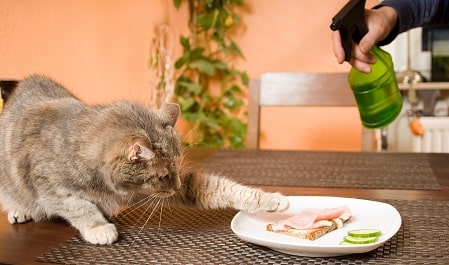
Spraying cats with a water bottle is very common advice, but is it actually okay?
It is okay to spray cats with water, but it’s not always the most effective solution to their misbehavior.
Spray bottles will get you immediate results, but after spraying the cat you must address the root of the problem. Do this by encouraging good behavior and discouraging or ignoring unwanted behavior. More permanent deterrents can also help.
For example, you can’t spray your cat every time they jump onto the countertop because you’re not always around. Therefore, your cat will still climb up there when you’re sleeping or at work.
But if you place a permanent deterrent, such as double-sided sticky tape on the counter, your cat will stop going onto the counter permanently.
Of course, these deterrents should always be humane and should never hurt your cat.
In addition, you may purchase a cat tree for the kitchen and encourage your cat to climb that instead using catnip, toys, treats, and encouragement.
In this article, I’ll explain when you should use a spray bottle, when you shouldn’t, and how to get your cat to listen without a spray bottle.
Spray Cats with Water as an Immediate Deterrent
Spraying cats with water works as an immediate deterrent, but is less likely to be effective long-term.
For instance, it’s perfectly fine to break up two fighting cats if needed by spraying them with water. But if all you do to manage their fighting from then on is to spray them when they fight, it isn’t going to work.
This is primarily because you aren’t going to be around to consistently spray them with water every single time it happens. You also aren’t addressing the root of the problem, which is why the cats are struggling to get along.
Instead, in this situation you would need to separate and reintroduce the cats. You may also need to give the attacking cat more play time, for instance.
In short, spraying cats with water is a quick fix if you need them to instantly stop what they are doing. It’s not cruel or inhumane—but in most other situations, it is ineffective.
It also comes with the unintended consequence of damaging your relationship with your cat. You don’t want them to see you as the one always spraying them with water!
Spraying Cats with Water is Typically Not Effective

The problem with spraying cats with water isn’t that it’s cruel or inhumane, but that it’s ineffective in most circumstances.
In general, punishment will only teach your cat to avoid punishment, not the action they’re being punished for.
In basic terms, they’ll stop the behavior while you’re around—but when you turn your back, there they go again!
For instance, I had this happen to me when the litter of cats I’ve raised were very young. They all knew that being on the counter wasn’t allowed when I was awake—but one night, I woke up and walked into the kitchen to find them all gathered up there.
Of course, they scattered in all directions upon seeing me.
They were smart enough to avoid the spray bottle by waiting until I was asleep to misbehave. Who knows how often they had counter meet-ups at midnight!
Punishments can also be incredibly detrimental to relationships. If your cat begins to associate you as the person who sprays them with water, they’ll become resentful and may not like you very much!
So if we want our cats to associate us with good things like pets and food, and we want them to actually behave, rather than become sneaky about their mischief, what can we do?
In the next few sections, I’ll give you some alternatives to deter and redirect your cat’s behavior. These should work as a more permanent solution.
Spraying Stressed Cats can Make Behaviors Worse

If your cat is displaying behaviors caused by stress, such as litterbox avoidance or fighting with other cats, spraying them with water can make their behavior worse instead of better.
In these situations, you will need to address the root of the problem. Stay calm while looking for a solution, even though these situations are often frustrating and stressful to us humans as well!
Any change in behavior should first be addressed by a check-up at the veterinarian to make sure your cat is in good shape. This is especially true for litter box avoidance problems or spraying, which is often caused by health issues.
Your veterinarian can also help to guide you in addressing the behavior if it is behavioral. They may suggest things like adding litter boxes to your home, changing the style of your current boxes or litter, or scooping the boxes more often.
If your cats are fighting or one is attacking the other in a non-playful manner, separate them immediately before more damage is done to their relationship or one of them seriously hurts the other.
Then begin the reintroduction process. This can be lengthy, but as someone who’s gone through these steps, it’s worth it in the end!
Redirect their Behavior
It’s much easier to redirect a behavior than to stop it completely. In some instances, this is the only way you and your cat will live happily together.
For instance, let’s say your cat is scratching your brand new couch. You have to stop this before they shred it to pieces!
But if you expect your cat not to scratch at all, that’s never going to work. Scratching is instinctual for cats.
Some people may turn to declawing in this instance, but declawing doesn’t just take a cat’s claws—it’s an amputation surgery that takespart of your cat’s toes as well.This inhumane process doesn’t just take your cat’s natural scratching instincts from them, but will also lead to health problems throughout your cat’s life.
Instead, you would fix your cat scratching the couch by providing several types of scratching posts in the places where your cat likes to hang out. Perhaps you place one right in front of the couch, and then move it gradually to a more convenient place once your cat is scratching it consistently.
When your cat claws at the furniture, gently move them to the scratching post instead. You can also apply catnip to the post to make it even more appealing.
This is a simple scenario, but you can apply this practice to almost any problem behavior. A cat who jumps on counters may need a more appealing kitchen perch. If your cat eats your houseplants, give them their own cat grass to munch on.
Once you have a place to redirect your cat’s behavior to, it’s time to make it super appealing for them! Sprinkle some cat nip around. Add toys or other activities to the area.
After you’ve given your cat this wonderful alternative, you can begin the next step: adding deterrents to the place you don’t want them to be!
Use Consistent Deterrents
You can’t stand guard forever to stop your cat from doing what they aren’t supposed to. You have to work and sleep!
This, along with damage to your relationship, is why you shouldn’t depend on spraying your cat with water.
Instead, use consistent deterrents that your cat won’t associate with you. There are plenty of options, from double-sided tape to scent deterrents to motion-activated devices that direct a burst of air at your cat.
Let’s go back to our example of a cat jumping on a counter. If they discover that they are met with something unpleasant every time, like a burst of air or sticky tape on their paws, they’ll eventually learn not to jump up there in the first place.
I’ve heard that you can then remove the deterrent, and your cat will still avoid the counters. However, this process has never worked for me.
Everyone’s experience is different, but my cats seem to need a permanent deterrent as they’ll try again every so often to see if things have changed. Maybe they’re just extra-stubborn, or maybe you’ll find this to be true for your cats as well.
The best thing about these deterrents, aside from the consistency, is that our cats typically don’t associate them with us, but with the action they’re performing. It acts almost like a natural consequence that they seek to avoid, rather than a punishment doled out by us.

I am a freelance writer who specializes in the pet industry. My full bio
References